History of Christianity - Class 1
Cultural Background
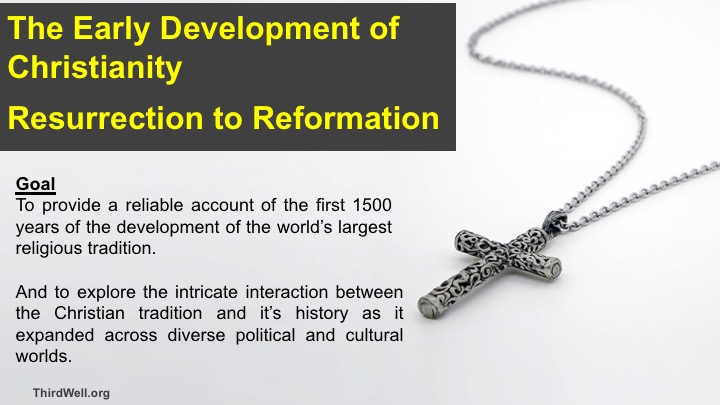
Goal
To provide a reliable account of the first 1500 years of the development of the world’s largest religious tradition.
And to explore the intricate interaction between the Christian tradition and it’s history as it expanded across diverse political and cultural worlds.
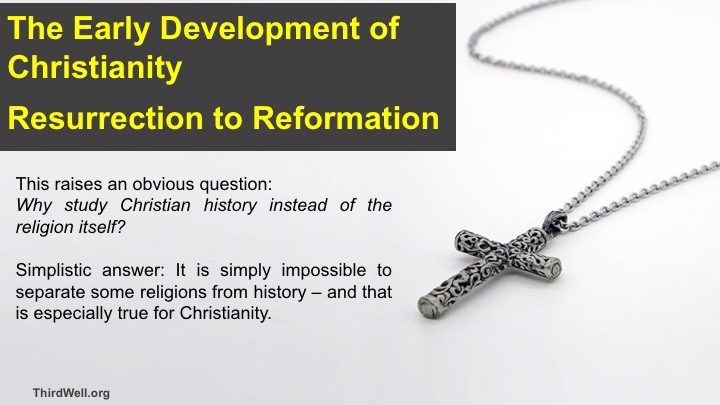
This raises an obvious question:
Why study Christian history instead of the religion itself?
Simplistic answer: It is simply impossible to separate some religions from history – and that is especially true for Christianity.
In fact, almost any historian will readily acknowledge that telling a coherent story about the history of the west cannot be done without simultaneously telling about the development of Christianity. They simply developed together. There is a reason that the political and cultural mix of Western European nations was referred to as Christendom. You will see that as the lessons proceed.
One of the reasons I can get excited about teaching a study like this is that real history is always much more complex and to me interesting than the more simple versions we tend to learn from our high school and even sometimes our college history courses. Unless, of course, you were a history major.
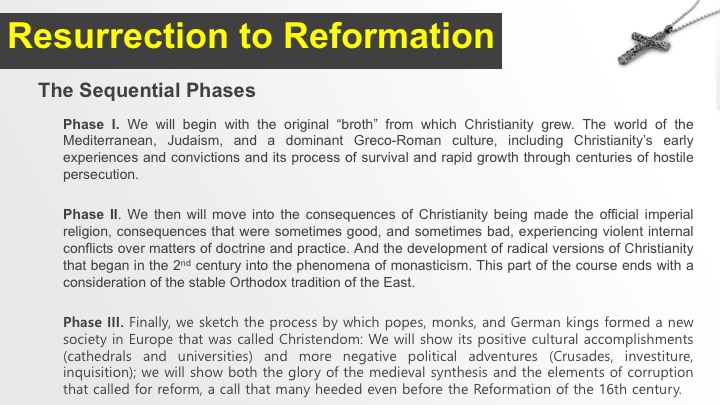
In doing this study we will progress through 3 phases sequentially. Each lasting multiple weeks.
In phase I we will begin at the beginning of Christianity’s rapid growth – immediately after the resurrection of Jesus. But we will first put things in context. This new movement occurred within a complex cultural mix of the Mediterranean world, the dominant Greco-Roman cultural empire, and Judaism. The early Christians lived in close quarters with all of this complex cultural mix during all of this first phase.
In phase II we will begin with the first major shift – and study the consequences of Christianity first becoming tolerated, and then being made the official imperial religion. We will learn that that shift did not come without significant problems, and led eventually to the evolution of different streams of Christianity.
And finally in phase III we will examine the complex process in which popes, monks, and German kings formed a new society in Europe that was called Christendom. Christendom had its plusses and minuses, all of which we will discuss, and the minuses eventually led to a growing call for reform that began well before the reformation of the 16th century.
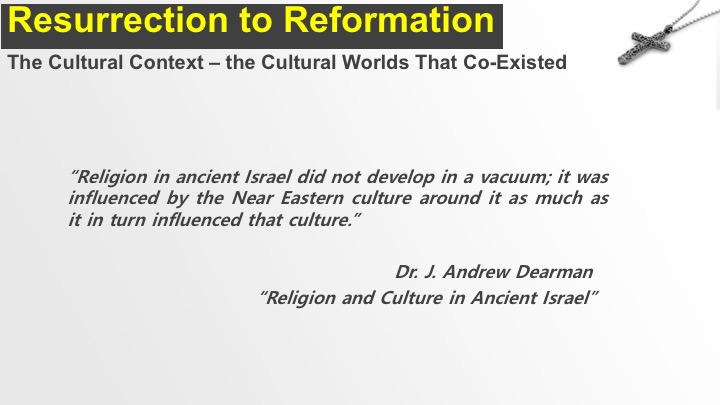
So, why are we emphasizing up front what the cultures of this Mediterranean or Near Eastern culture were. Simply because religious scholars are in almost universal agreement that religions are in fact influenced by the cultures in which they develop.
This is a quote from a well known scholar of religion regarding how the religion of ancient Israel developed.
"Religion in ancient Israel did not develop in a vacuum; it was influenced by the Near Eastern culture around it as much as it in turn influenced that culture.”
J. Andrew Dearman . "Religion and Culture in Ancient Israel"
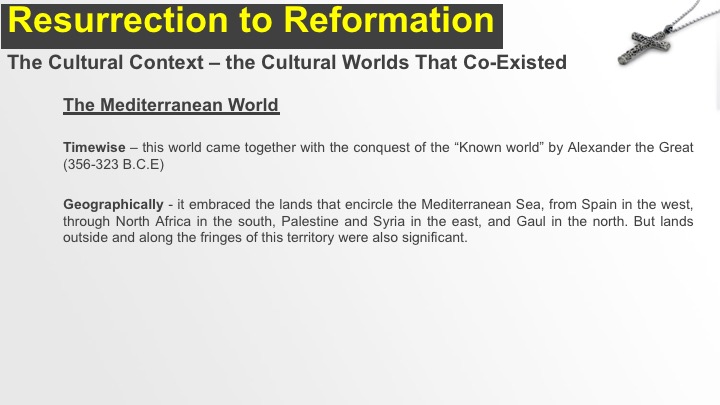
We must first start then with the cultural context – what was the soup that Christianity grew from? Like other religions of the West, Christianity is grounded in the material world and, at every stage, is shaped by cultural circumstances. It is not a timeless form of spirituality that teaches its adherents to liberate themselves from the body or involvement in society. Rather, Christianity was born at a certain time and place and bears within it the imprint of the cultures from which it originated and grew. Further, such cultural conditioning does not apply only at the beginning but throughout Christianity’s long history. Christianity is a religion that constantly emerges from, adapts, and reshapes the cultures that it engages.
So what are these cultures? We begin with the Mediterranean World.
Timewise – this world came together with the conquest of the “Known world” by Alexander the Great (356-323 B.C.E).
Geographically - it embraced the lands that encircle the Mediterranean Sea, from Spain in the west, through North Africa in the south, Palestine and Syria in the east, and Gaul in the north. But lands outside and along the fringes of this territory were also significant.
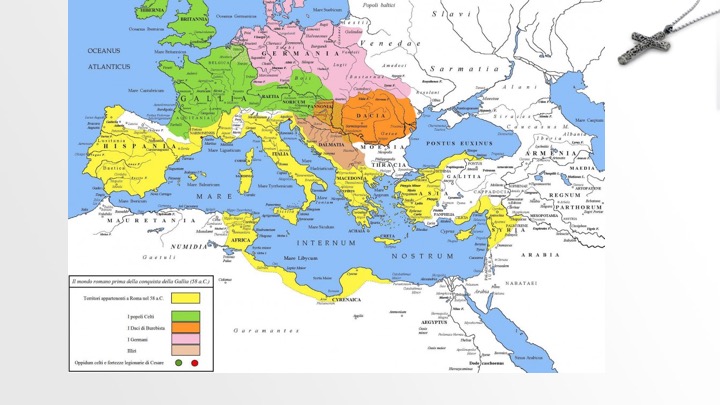
The Mediterranean world we are addressing is roughly the yellow areas of this ancient map - lands that lie close to the Mediterranean.
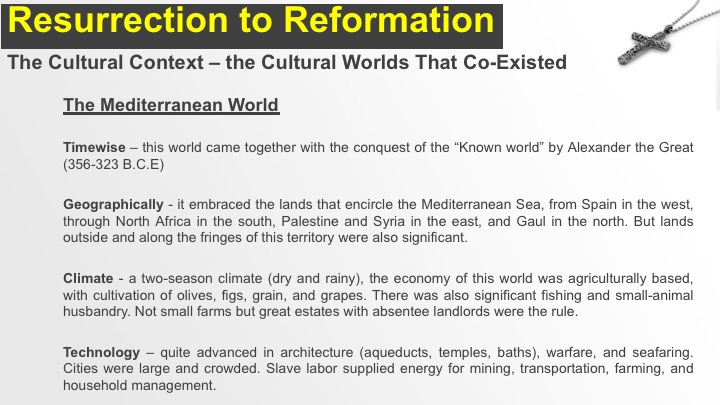
Climate - a two-season climate (dry and rainy), the economy of this world was agriculturally based, with cultivation of olives, figs, grain, and grapes. There was also significant fishing and small-animal husbandry. Not small farms but great estates with absentee landlords were the rule.
Technology – quite advanced in architecture (aqueducts, temples, baths), warfare, and seafaring. Cities were large and crowded. Slave labor supplied energy for mining, transportation, farming, and household management.
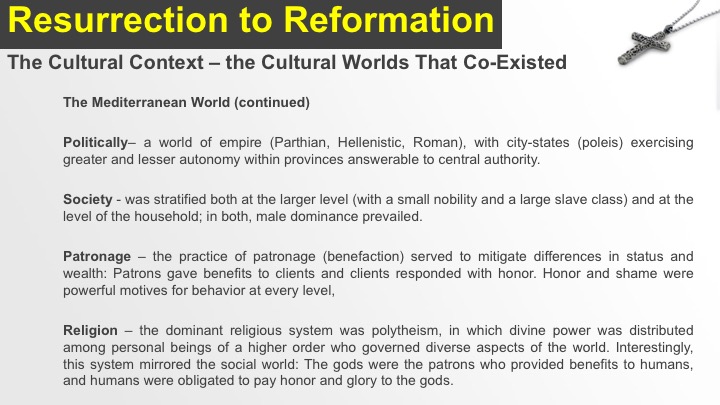
Politically, it was a world of empire (Parthian, Hellenistic, Roman), with city-states (poleis) exercising greater and lesser autonomy within provinces answerable to central authority.
Certain aspects of “Mediterranean culture” preceded and persisted through changes of imperial rule.
Society was stratified both at the larger level (with a small nobility and a large slave class) and at the level of the household; in both, male dominance prevailed.
The practice of patronage (benefaction) served to mitigate differences in status and wealth: Patrons gave benefits to clients and clients responded with honor.
Of special note, the term household, which occurs in the New Testament many times, meant something very different in a Patronage based society. There were no small households like we think of in modern America or Europe. A household normally would include, in addition to a father (the main Patron) and mother and the children, grandparents, uncles, aunts, 1st, 2nd, and 3rd cousins, etc. And outside of blood relatives there could be many clients that had joined the system to do work for the main patron or sub-patrons. At the bottom of the structure would be household slaves. A "household" could easily be 100-200 people, not in the same house but in neighboring houses.
Honor and shame were powerful motives for behavior at every level, the clients always obeyed the Patron, and the Patron provided appropriate benefits for the clients to avoid being shamed by others as a "bad" Patron.
The dominant religious system was polytheism, in which divine power was distributed among personal beings of a higher order who governed diverse aspects of the world. Interestingly, this system mirrored the social world: The gods were the patrons who provided benefits to humans, and humans were obligated to pay honor and glory to the gods.
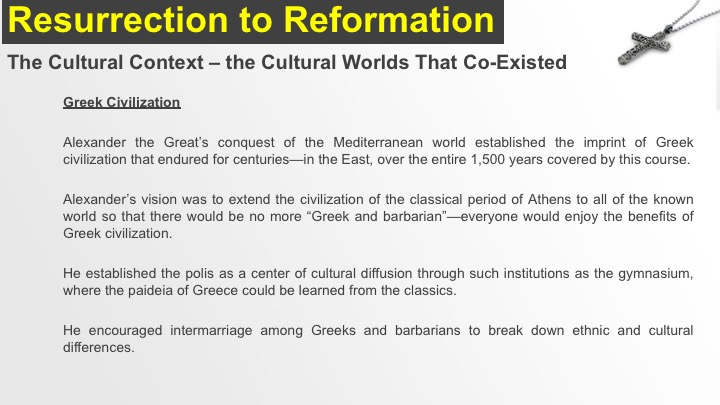
Alexander the Great’s conquest of the Mediterranean world established the imprint of Greek civilization that endured for centuries—in the East, over the entire 1,500 years covered by this course.
Alexander’s vision was to extend the civilization of the classical period of Athens to all of the known world so that there would be no more “Greek and barbarian”—everyone would enjoy the benefits of Greek civilization.
He established the polis as a center of cultural diffusion through such institutions as the gymnasium, where the paideia of Greece could be learned from the classics.
Paideia – the rearing and education of the ideal citizen. Included the liberal arts, scientific studies, music, philosophy. And in addition gymnastics and wrestling.
He encouraged intermarriage among Greeks and barbarians to break down ethnic and cultural differences.
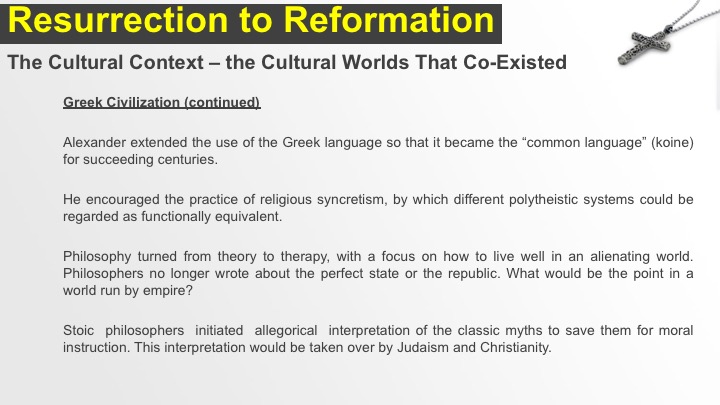
He extended the use of the Greek language so that it became the “common language” (koine) for succeeding centuries.
He encouraged the practice of religious syncretism, by which different polytheistic systems could be regarded as functionally equivalent.
The ideal that Alexander sought was “cosmopolitanism,” a sense of world citizenship that would derive from always having available the forms of Greek civilization.
The effect of empire was to distort the very values that Alexander sought to propagate: Hellenism was something other than ancient Athenian culture.
The city-state of Athens had citizen participation, which was lost in empire and in huge metropolises.
Further, the Attic Greek of Athens was influenced by Semitic languages as it was extended so that the koine of the empire was not exactly the same language as that used by Sophocles and Plato.
Athenian culture was intensely local, but making it universal reduced its effect. The most highly mobile members of society felt most acutely that the flip side of cosmopolitanism is social alienation or anomie.
Developments in Hellenistic religion and philosophy corresponded to new social realities.
Although the civic festivals remained central and popular and the Olympic pantheon active, new aspects of religion emerged. Chance (tyche) and fate (heimarmene) emerged as inexorable forces superior to the gods themselves. Religious associations and mystery cults offered salvation from fate and chance, as well as a place in the world.
Philosophy turned from theory to therapy, with a focus on how to live well in an alienating world. Philosophers no longer wrote about the perfect state or the republic. What would be the point in a world run by empire?
Philosophical schools, such as those of the Pythagoreans and Epicureans, offered an organized form of life—a community life that provided sound teaching, sound practice, and the opportunity to live in a face-to-face community of moral integrity in the midst of a world that made little sense. Philosophers focused on the cultivation of virtue and the healing of the soul.
Stoic
philosophers initiated allegorical
interpretation of the classic
myths to save them for moral instruction. This interpretation would be taken
over by Judaism and Christianity.
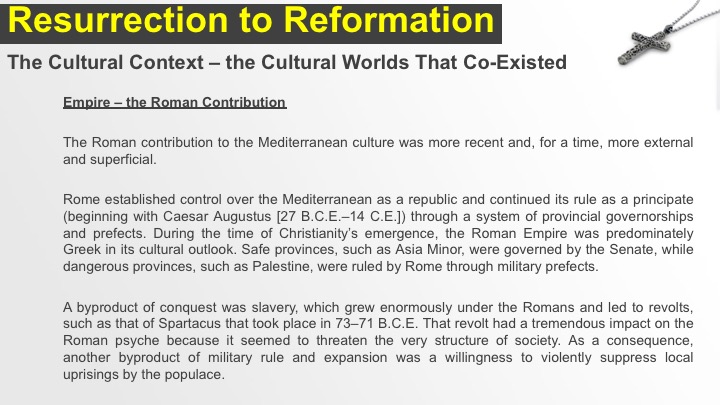
Empire – the Roman Contribution
The Roman contribution to the Mediterranean culture was more recent and, for a time, more external and superficial.
Rome established control over the Mediterranean as a republic and continued its rule as a principate (beginning with Caesar Augustus [27 B.C.E.–14 C.E.]) through a system of provincial governorships and prefects. During the time of Christianity’s emergence, the Roman Empire was predominately Greek in its cultural outlook. Safe provinces, such as Asia Minor, were governed by the Senate, while dangerous provinces, such as Palestine, were ruled by Rome through military prefects.
A byproduct of conquest was slavery, which grew enormously under the Romans and led to revolts, such as that of Spartacus that took place in 73–71 B.C.E. That revolt had a tremendous impact on the Roman psyche because it seemed to threaten the very structure of society. As a consequence, another byproduct of military rule and expansion was a willingness to violently suppress local uprisings by the populace.
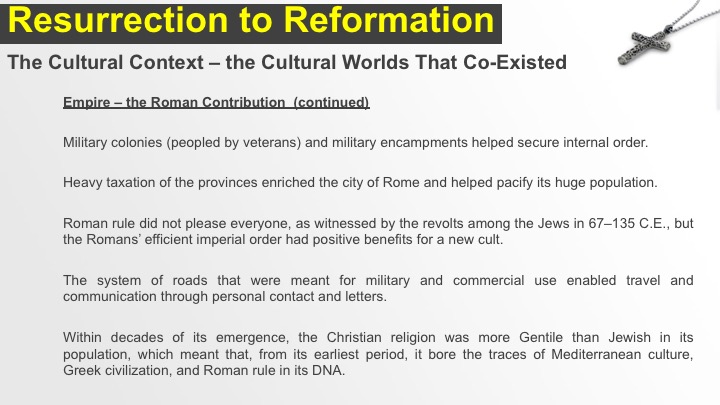
Empire – the Roman Contribution (continued)
Military colonies (peopled by veterans) and military encampments helped secure internal order.
Heavy taxation of the provinces enriched the city of Rome and helped pacify its huge population.
Roman rule did not please everyone, as witnessed by the revolts among the Jews in 67–135 C.E., but the Romans’ efficient imperial order had positive benefits for a new cult.
The system of roads that were meant for military and commercial use enabled travel and communication through personal contact and letters.
Within decades of its emergence, the Christian religion was more Gentile than Jewish in its population, which meant that, from its earliest period, it bore the traces of Mediterranean culture, Greek civilization, and Roman rule in its DNA.
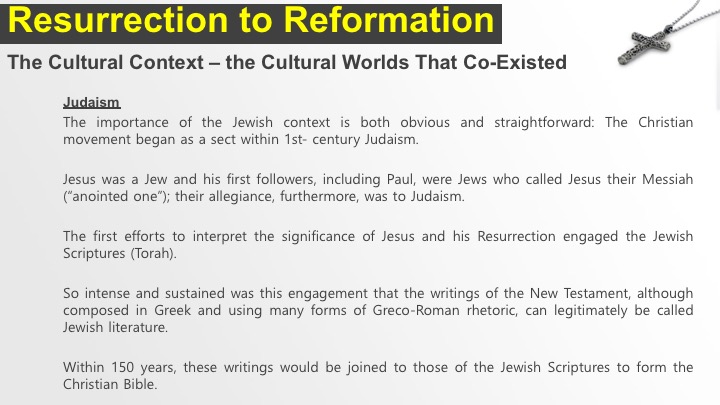
We saw how important Greek and Roman culture was for understanding earliest Christianity, not merely as a static setting but as a set of living influences. Now, we’ll examine the most important and problematic cultural context for early Christianity, namely Judaism, the “symbolic world of Torah.” As we’ll see, the importance of this context is both straightforward and problematic—straightforward in that the Christian movement began as a sect within 1st-century Judaism and attempted to engage the Jewish Scriptures and problematic in that the Christian claim that Jesus was the risen Lord appeared as heretical within Judaism.
Jesus was a Jew and his first followers, including Paul, were Jews who called Jesus their Messiah (“anointed one”); their allegiance, furthermore, was to Judaism.
The first efforts to interpret the significance of Jesus and his Resurrection engaged the Jewish Scriptures (Torah).
So intense and sustained was this
engagement that the writings of the New Testament, although composed in Greek
and using many forms of Greco-Roman rhetoric, can legitimately be called Jewish
literature.
Within 150 years, these writings would be joined to those of the Jewish Scriptures to form the Christian Bible.
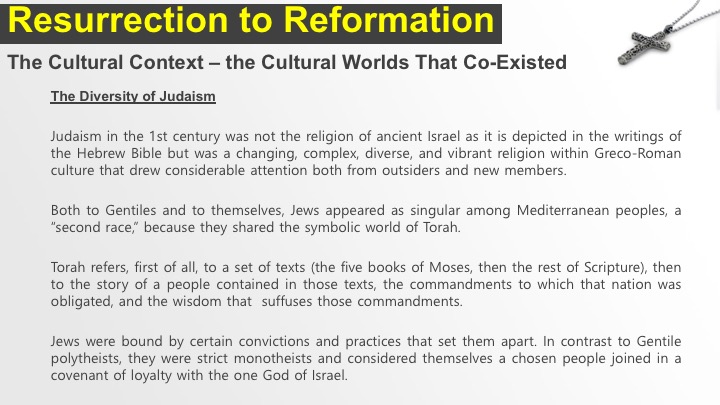
The Diversity of Judaism
Judaism in the 1st century was not the religion of ancient Israel as it is depicted in the writings of the Old Testament but was a changing, complex, diverse, and vibrant religion within Greco-Roman culture that drew considerable attention both from outsiders and new members.
Both to Gentiles and to themselves, Jews appeared as singular among Mediterranean peoples, a “second race,” because they shared the symbolic world of Torah.
Torah refers, first of all, to a set of texts (the five books of Moses, then the rest of Scripture), then to the story of a people contained in those texts, the commandments to which that nation was obligated, and the wisdom that suffuses those commandments.
Jews were bound by certain convictions and practices that set them apart. In contrast to Gentile polytheists, they were strict monotheists and considered themselves a chosen people joined in a covenant of loyalty with the one God of Israel.
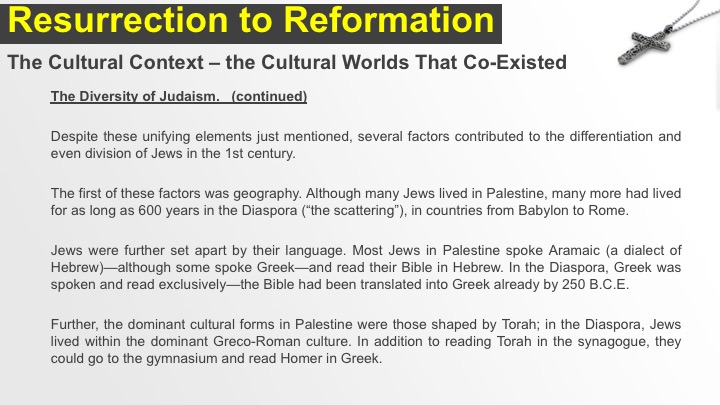
The Diversity of Judaism. (continued)
Despite these unifying elements just mentioned, several factors contributed to the differentiation and even division of Jews in the 1st century.
The first of these factors was geography. Although many Jews lived in Palestine, at least twice as many had lived for as long as 600 years in the Diaspora (“the scattering”), in countries from Babylon to Rome.
Jews were further set apart by their language. Most Jews in Palestine spoke Aramaic (a dialect of Hebrew)—although some spoke Greek—and read their Bible in Hebrew. In the Diaspora, Greek was spoken and read exclusively—the Bible had been translated into Greek already by 250 B.C.E.
Further, the dominant cultural forms in Palestine were those shaped by Torah; in the Diaspora, Jews lived within the dominant Greco-Roman culture. In addition to reading Torah in the synagogue, they could go to the gymnasium and read Homer in Greek.
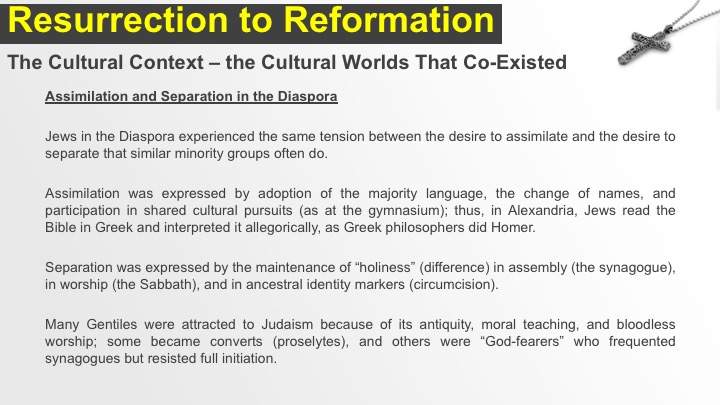
Assimilation and Separation in the Diaspora
Jews in the Diaspora experienced the same tension between the desire to assimilate and the desire to separate that similar minority groups often do.
Assimilation was expressed by adoption of the majority language, the change of names, and participation in shared cultural pursuits (as at the gymnasium); thus, in Alexandria, Jews read the Bible in Greek and interpreted it allegorically, as Greek philosophers did Homer.
Separation was expressed by the maintenance of “holiness” (difference) in assembly (the synagogue), in worship (the Sabbath), and in ancestral identity markers (circumcision).
Many Gentiles were attracted to Judaism because of its antiquity, moral teaching, and bloodless worship; some became converts (proselytes), and others were “God-fearers” who frequented synagogues but resisted full initiation.
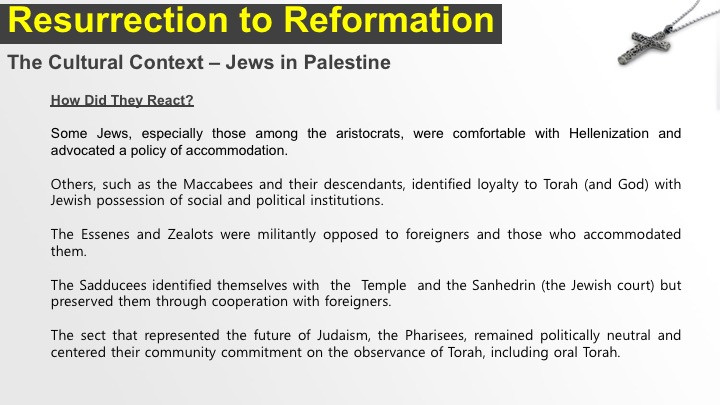
How Did They React?
Some Jews, especially those among the aristocrats, were comfortable with Hellenization and advocated a policy of accommodation.
Others, such as the Maccabees and their descendants, identified loyalty to Torah (and God) with Jewish possession of social and political institutions.
The Essenes and Zealots were militantly opposed to foreigners and those who accommodated them.
The Sadducees identified themselves with the Temple and the Sanhedrin (the Jewish court) but preserved them through cooperation with foreigners.
The sect that represented the future of Judaism, the Pharisees, remained politically neutral and centered their community commitment on the observance of Torah, reinterpreted through scribal technique (midrash).
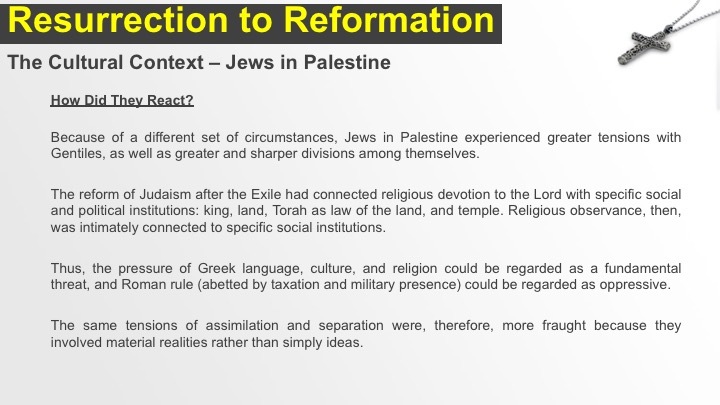
How Did They React?
Because of a different set of circumstances, Jews in Palestine experienced greater tensions with Gentiles, as well as greater and sharper divisions among themselves.
The reform of Judaism after the Exile had connected religious devotion to the Lord with specific social and political institutions: king, land, Torah as law of the land, and temple. Religious observance, then, was intimately connected to specific social institutions.
Thus, the pressure of Greek language, culture, and religion could be regarded as a fundamental threat, and Roman rule (abetted by taxation and military presence) could be regarded as oppressive.
The same tensions of assimilation and separation were, therefore, more fraught because they involved material realities rather than simply ideas.
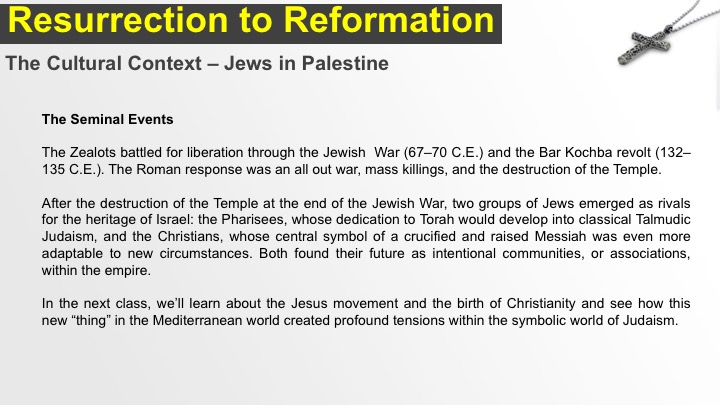
The Seminal Events
The Zealots battled for liberation through the Jewish War (67–70 C.E.) and the Bar Kochba revolt (132–135 C.E.). The Roman response was an all out war, mass killings, and the destruction of the Temple.
After the destruction of the Temple at the end of the Jewish War, two groups of Jews emerged as rivals for the heritage of Israel: the Pharisees, whose dedication to Torah would develop into classical Talmudic Judaism, and the Christians, whose central symbol of a crucified and raised Messiah was even more adaptable to new circumstances. Both found their future as intentional communities, or associations, within the empire.
In the next class, we’ll learn about the Jesus movement and the birth of Christianity and see how this new “thing” in the Mediterranean world created profound tensions within the symbolic world of Judaism.
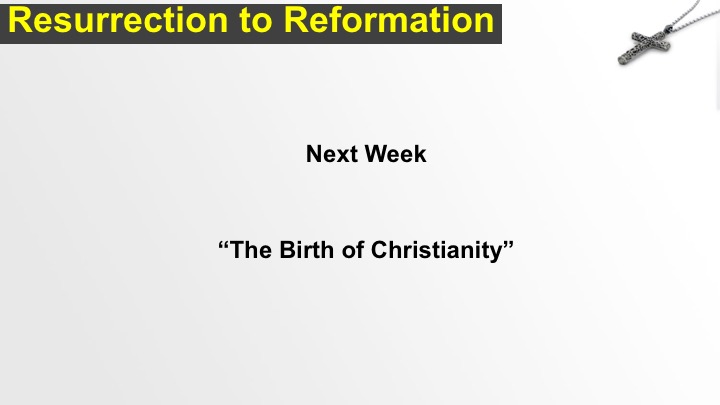
And so in our next lesson we will move on
to “The Birth of Christianity”.